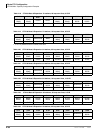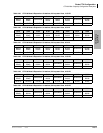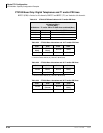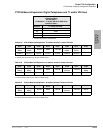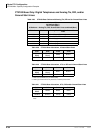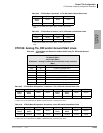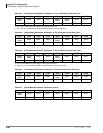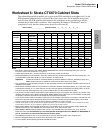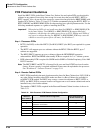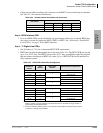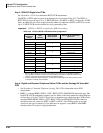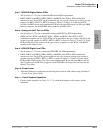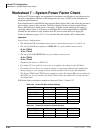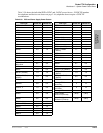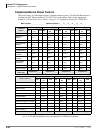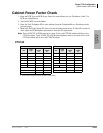
Strata CTX Configuration
Worksheet 6: Strata CTX670 Cabinet Slots
2-38 Strata CTX I&M 06/04
PCB Placement Guidelines
Install the RRCU PCBs in the Base Cabinet first. Station, line and option PCBs can be mixed in
cabinets in any pattern. Do not skip slots except for vacant slots that provide RDTU, BPTU or
RPTU capacity. Also, do not skip slots except for vacant slots that provide for BBKU/BDKS with
Speaker OCA. Refer to Tables 2-54 and 2-55. Toshiba recommends placing the RDTU, BPTU or
RPTU, BWDKU and BDKU/BDKS PCBs first because they have special placement rules. Use the
following numbered sequence as a guide to installing the PCBs.
Important! When placing PCBs, do not install more than five BWDKU or BDKU/BDKS PCBs
in the same cabinet. Five BWDKU or BDKU/BDKS PCBs support 80 digital
telephones, which brings the cabinet power factor to 82.25. Adding more PCBs of
any type to a cabinet that has five BWDKU or BDKU/BDKS PCBs may cause the
cabinet to exceed its power factor (85 max.). See Worksheet 7.
Step 1: Processor PCBs
• BCTU (slot B102) or the older BECU (Slot B101)/ BBCU (slot B102), are required for system
operation.
• The BCTU will support up to two cabinets without the BEXU. With the BEXU, up to 7
cabinets are supported.
• The BECU/BBCU supports up to two cabinets without the BEXS/BBMS expansion
subassemblies. BEXS and BBMS subassembly PCBs are required for 3 to 7 cabinet systems.
• BSIS subassembly PCB is required for SMDR and/or SMDI or Toshiba Proprietary Voice Mail
RS-232 interface.
Note The BECU/BBCU and BCTU is licensed for 64 ports and four DTMF receivers from the
factory. If more capacity is required additional licenses must be uploaded to the processor.
See “Worksheet 9 – Software Licenses” on page 2-54.
Step 2: Remote Cabinet PCBs
• RRCU PCBs installed in the main location must be placed in Base Cabinet slots S102~S108 in
any order. Before installing other PCBs make sure there is a Base Cabinet slot available for
each RRCU PCB needed. An RRCU may occupy a vacant slot adjacent to RDTU, BPTU or
RPTU. An RRCU PCB in a remote location can support one or two remote cabinets and can be
installed in any slot of either cabinet.
The number of RRCU PCBs required in the Base and Remote Cabinet locations is shown in
Table 2-52:
Table 2-52 Main Processor PCB/ Remote Cabinet Configuration
RRCU PCBs
Needed in
Base Cabinet
Remote Cabinet Configuration
RRCU PCBs Needed at
Remote Location (s)
1 1 or 2 Remote Cabinets in one location 1
2
2 to 4 Remote Cabinets in two locations or 3 to 4 Remote
cabinets in one location.
2
3 3 cabinets if cabinets are in separate remote locations. 3
4 4 cabinets if cabinets are in separate remote locations. 4
5 5 cabinets if cabinets are in separate remote locations. 5
6 6 cabinets if cabinets are in separate remote locations. 6



